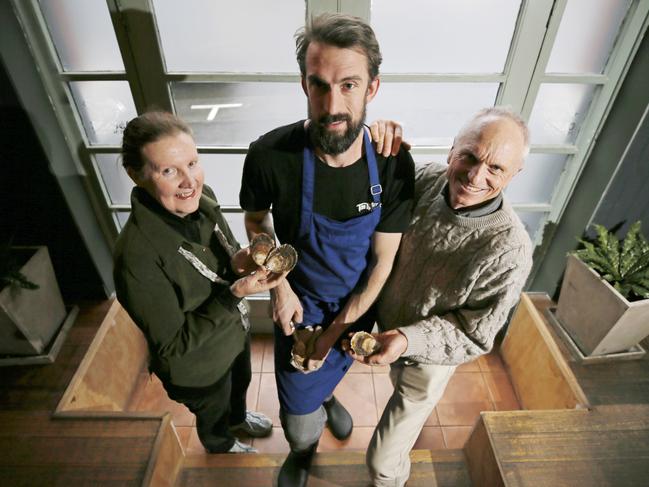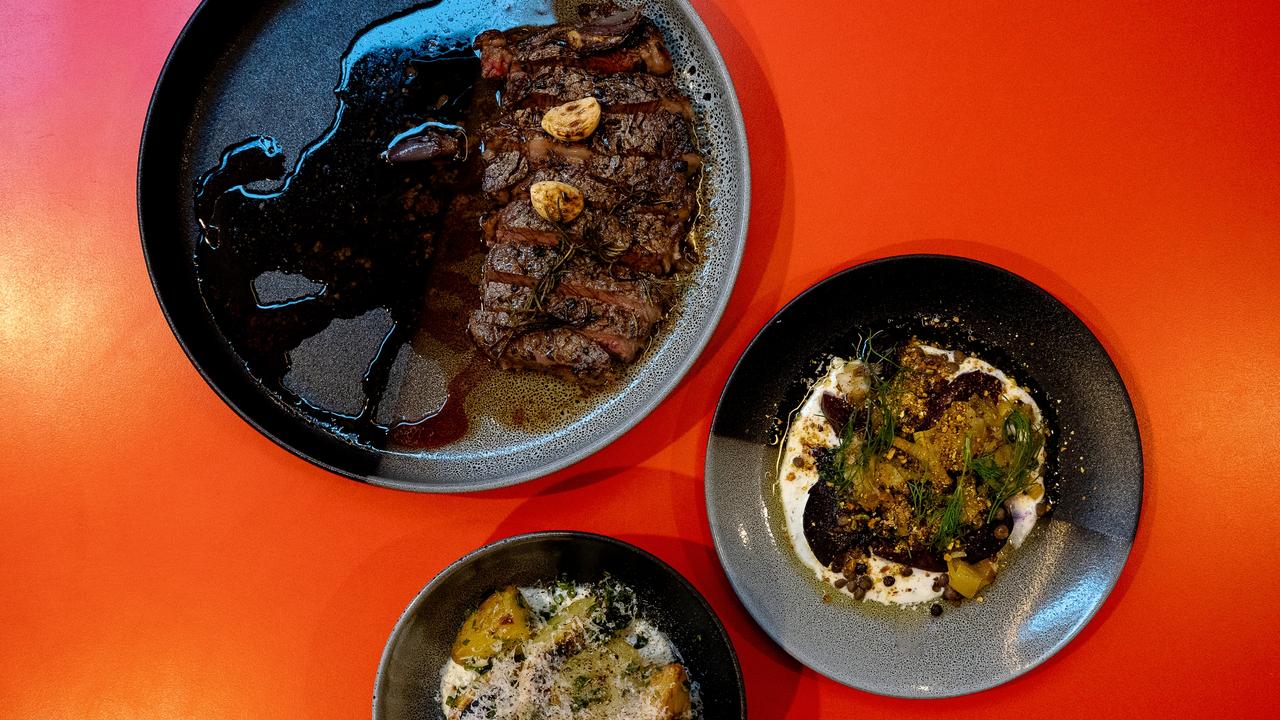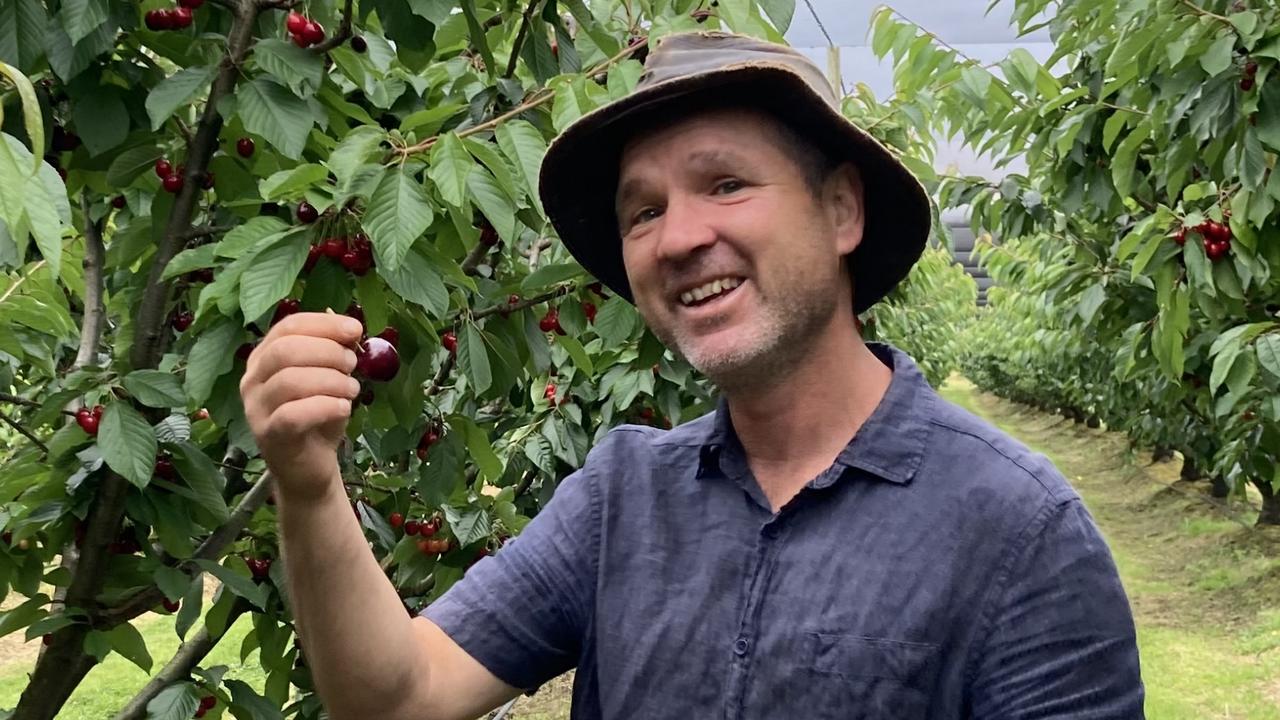Delicious Awards: Tassie seafood company The Oyster Province wins delicious reward
Elaine Reeves talks to the winners of one of Australia’s most prestigious food awards.
Food and Wine
Don't miss out on the headlines from Food and Wine. Followed categories will be added to My News.
SPAT from native angasi oysters were being right pests when they set up home on the “gorgeous, shiny black shells” of mussels Yvonne Young and Steve Leslie were growing off the Tasman Peninsula.
The couple decided to try growing a bucketful of the white freeloaders scrapped off the mussels to see what would happen.
What happened was “a total mess” said Yvonne. “They really were pretty revolting — chalky, very thick shells. They did not look like a good thing.
“When we look back, we really wonder what made us keep going.”
But The Oyster Province did keep going for the next 10 years, and last night they were awarded a gold medal in the delicious Harvey Norman Produce Awards in Sydney.
That is on top of a gold medal in the recent Royal Fine Food Awards in Hobart and an entry in the Australian Food Awards in Victoria still to be judged.
Steve said they had entered in awards “trying to raise interest in them, trying to get the name angasi out there”.
And now he hopes the awards will improve sales and convince other growers to start growing them.
It is angasi oyster shells that form the metres-thick middens about our coastline, built up over thousands of years by feasting First Peoples.
But when white settlers arrived they quickly harvested them almost to extinction in the late 1800s.
And when Japan delivered Pacific oysters to Tasmania as part of war reparations in the 1950s, the slower-growing angasi oysters were left in the too-hard basket.
Steve and Yvonne have improved the characteristics of native oysters by taking them out of their comfort zone.
Given their druthers, the oysters would stay in deep water. Instead, they grow them in where they get tidal exposure to the air.
When the oysters are exposed to the air they shut their adductor muscles, which strengthens the muscles and gives them a longer shelf life after harvest. The practice also kills biofouling on the shells.
In the 1990s, Steve spent five years of “innovation and fun” working in the mussel industry in the Marlborough Sounds in New Zealand. He has adapted (and patented) techniques he learned there.
He says there still are improvements they think they can make, but now they have a product “that people think is pretty good”.
Two stalwarts who have been “right there for us from the start” are chefs Analiese Gregory from Franklin in Hobart and Tom Westcott from Tom McHugo’s across the road.
Tom said he likes the angasi because they are endemic to Tasmania and because “they taste to me of where I grew up, down on the peninsula.
You open them and immediately smell the sea.

“Steve and Yvonne have done an impressive job taking something no one else has managed to grow on a commercial scale,” Tom said.
It does not matter to Tom that angasi oysters are available only between July and October, — and generally he does not have oysters on the menu at others times of year.
Steve said 95 per cent of the oysters eaten in the world are one species — the Pacific oyster — and now there is a worldwide trend to bring diversity into oysters.
Native species in the USA and New Zealand are being encouraged to thrive and/or re-establish. The Nature Conservancy of Australia is working to re-establish angasi oyster reefs around Australia.
The only Tasmanian reef remaining is off St Helens.
Yvonne said the European flat oyster Ostrea edulis, variously known as Colchester and Belon oysters, are from the same family as Ostrea angasi.
“I think they taste similar, but we have not tasted them,” she said.
That may soon change, because The Oyster Province was last night announced the winner of The Alla Wolf-Tasker Good Food Matters scholarship worth $5000 — money that will help Steve and Yvonne visit marine farms throughout Europe, Ireland and the US.
Alla Woolf-Tasker said she hopes their subsequent report “will serve as an inspiration for others to join in the production of this delicious oyster”.
The state judges for the awards were Analiese Gregory, Rodney Dunn, Philippe Leban and Christian Ryan. They selected 11 Tasmanian finalists earlier this year.
Three of these won gold medals: The Oyster Province, Bruny Island Cheese for Raw Milk C2 and Elgaar Farm for fresh organic milk.
The In the Bottle prize was won by Hartshorn Sheep Whey Vodka, made by Ryan Hartshorn at Grandvewe (pictured inset on the list).
WINNERS
FROM THE DAIRY
TROPHY WINNER
Pecora Dairy Raw Milk Feta NSW
GOLD MEDALLISTS
> Bruny Island Cheese Co. Raw Milk c2 (TAS)
> Burraduc Farm DolceNina Fresh Buffalo Curd (NSW)
> Elgaar Farm Fresh Organic Milk (TAS)
> L’Artisan Cheese Marcel (VIC)
> Mungalli Creek Pot Set Bio-dynamic Natural Yoghurt (QLD)
> Prom Country Cheese Venus Blue (VIC)
FROM THE EARTH
TROPHY WINNER
Spurrell Foraging Native & Seasonal Edible Plants (VIC)
FROM THE PADDOCK
TROPHY WINNER
Eugowra Game Birds Pastured Quail (NSW)
FROM THE SEA
TROPHY WINNER
Chris Bolton Fishing Wild Red Emperor (QLD)
BEST NEW PRODUCT
Tuerong Farm Premium Stoneground Flour (VIC)
PRODUCER OF THE YEAR
Bruce Collis Seasonal Wild Caught Fish (VIC)
IN THE BOTTLE
Hartshorn Sheep Whey Vodka (TAS)
VITICULTURIST
Melissa Brown Gemtree Wines (SA)
FARMERS’ MARKET
Willunga Farmers Market (SA)
NEXT-GEN CHEF
Alanna Sapwell ARC Dining (QLD)
NATIVE PRODUCER
Clarence Slockee & Christian Hampson, Yerrabingin (NSW)
OUTSTANDING ARTISAN
Leo Gelsomino Lello Pasta Bar (VIC)
THE ALLA WOLF-TASKER GOOD FOOD MATTERS
SCHOLARSHIP
The Oyster Province (TAS)
MAGGIE BEER AWARD
FOR OUTSTANDING
CONTRIBUTION
Joost Bakker
Read more about the awards in delicious out on August 22.


